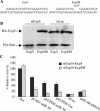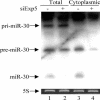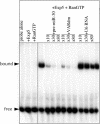Exportin-5 mediates the nuclear export of pre-microRNAs and short hairpin RNAs
- PMID: 14681208
- PMCID: PMC305252
- DOI: 10.1101/gad.1158803
Exportin-5 mediates the nuclear export of pre-microRNAs and short hairpin RNAs
Abstract
MicroRNAs (miRNAs) are initially expressed as long transcripts that are processed in the nucleus to yield approximately 65-nucleotide (nt) RNA hairpin intermediates, termed pre-miRNAs, that are exported to the cytoplasm for additional processing to yield mature, approximately 22-nt miRNAs. Here, we demonstrate that human pre-miRNA nuclear export, and miRNA function, are dependent on Exportin-5. Exportin-5 can bind pre-miRNAs specifically in vitro, but only in the presence of the Ran-GTP cofactor. Short hairpin RNAs, artificial pre-miRNA analogs used to express small interfering RNAs, also depend on Exportin-5 for nuclear export. Together, these findings define an additional cellular cofactor required for miRNA biogenesis and function.
Figures





References
-
- Ambros V. 2003. MicroRNA pathways in flies and worms: Growth, death, fat, stress, and timing. Cell 113: 673-676. - PubMed
-
- Bernstein E., Caudy, A.A., Hammond, S.M., and Hannon, G.J. 2001. Role for a bidentate ribonuclease in the initiation step of RNA interference. Nature 409: 363-366. - PubMed
-
- Bollman K.M., Aukerman, M.J., Park, M.-Y., Hunter, C., Berardini, T.Z., and Poethig, R.S. 2003. HASTY, the Arabidopsis ortholog of exportin 5/MSN5, regulates phase change and morphogenesis. Development 130: 1493-1504. - PubMed
-
- Bridge A.J., Pebernard, S., Ducraux, A., Nicoulaz, A.-L., and Iggo, R. 2003. Induction of an interferon response by RNAi vectors in mammalian cells. Nat. Genet. 34: 263-264. - PubMed
Publication types
MeSH terms
Substances
Grants and funding
LinkOut - more resources
Full Text Sources
Other Literature Sources
Molecular Biology Databases
Research Materials
Miscellaneous
